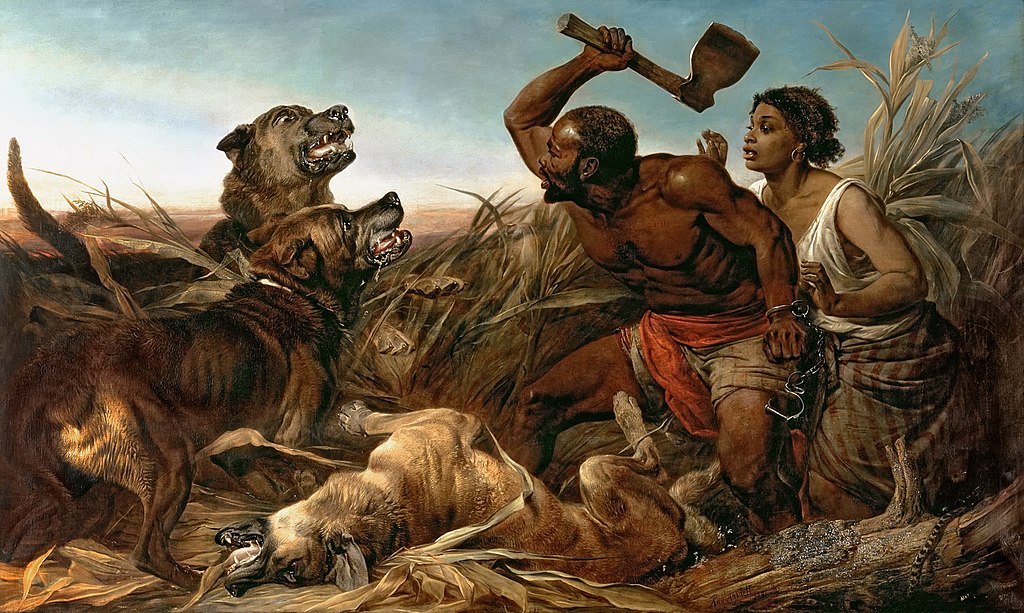
“The Hunted Slaves” by Richard Ansdell depicts two African American slaves who have escaped into the wilderness, facing down a pack of savage hunting dogs as the slaves flee. The man is heroically defending his terrified wife with an ax. This powerful visual indictment of slavery in the United States was painted in 1861, the same year as the outbreak of the American Civil War.
The United Kingdom remained officially neutral throughout the American Civil War (1861–1865). It legally recognized the belligerent status of the Confederate States of America (CSA) but never recognized it as a nation. Over 90 percent of Confederate trade with Britain ended, causing a severe shortage of cotton by 1862. A “cotton famine” led to hardship in the mill towns of Lancashire. British private interests financed blockade runners that sent munitions and luxuries to Confederate ports in return for cotton and tobacco. They were legal under international law and caused no dispute between the US and Britain.
Ansdell donated ‘The Hunted Slaves’ to a lottery held to raise money for the relief of the “cotton famine.” This work is currently on loan to the International Slavery Museum in Liverpool.
The United Kingdom and the American Civil War
The British elite tended to support the Confederacy, but ordinary people tended to support the North. Large-scale trade continued between Britain and the US. The US shipped grain to Britain, and Britain sent manufactured items and munitions to the US. Immigration continued into the US, and the fact that British private interests operated blockade runners was not a cause of severe tension.
Lincoln’s Emancipation Proclamation, announced in 1862, made ending slavery an objective of the war and caused European intervention on the side of the South to be unpopular. Throughout the war, European powers adopted a policy of neutrality, meeting informally with Confederate diplomats but withholding diplomatic recognition. They applied the principles of international law and recognized both sides as belligerents. Canada allowed both Confederate and Union agents to work openly within its borders.
The eventual Union victory emboldened the liberal forces in Britain that demanded more democracy and public input into the political system. The resulting Reform Act 1867 enfranchised the urban male working class and weakened the upper-class landed gentry, who identified more with the Southern planters.
Richard Ansdell
Richard Ansdell (1815 – 1885) was a British painter of animals and genre scenes. Born in Liverpool, his father died young, and Richard was educated at The Liverpool Blue Coat school for orphans. He had a natural talent for art from an early age, and after leaving school worked for a portrait painter in Kent and also spent time as a painter in the Netherlands.
He first exhibited at the Liverpool Academy in 1835, and his animal and rural subjects proved to be popular, and he soon attracted wealthy patrons. One of the largest public collections of Ansdell’s paintings in Britain is in Liverpool’s Walker Art Gallery.
Reflections
- Can a powerful indictment in art still move us today?
The Hunted Slaves
- Title: The Hunted Slaves
- Artist: Richard Ansdell
- Date: 1861
- Medium: Oil on Canvas
- Dimensions: Height: 184 cm (72.4 ″); Width: 308 cm (10.1 ft)
- Museum: Walker Art Gallery
Richard Ansdell
- Artist: Richard Ansdell
- Born: 1815, Liverpool, England
- Died: 1885 (aged 69)’ Farnborough, England
- Nationality: British
- Notable works:
- The Hunted Slaves
Explore the Walker Art Gallery
- “Isabella” by John Everett Millais
- “The Martyr of Solway” by John Everett Millais
- “Perseus and Andromeda” by Frederic Leighton
- Elaine by Sophie Gengembre Anderson
- “Echo and Narcissus” by John William Waterhouse
- Fantine by Margaret Bernadine Hall
- “The Hunted Slaves” by Richard Ansdell
- Masterpieces of the Walker Art Gallery
~~~
“Whenever I hear anyone arguing for slavery, I feel a strong impulse to see it tried on him personally.”
– Abraham Lincoln
~~~
Photo Credit: Richard Ansdell [Public domain]
Popular this Week








 Sponsor your Favorite Page
Sponsor your Favorite Page SEARCH Search for: Search Follow UsJoin – The JOM Membership Program
Sponsor a Masterpiece with YOUR NAME CHOICE for $5
Share this:
- Tweet
